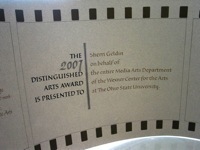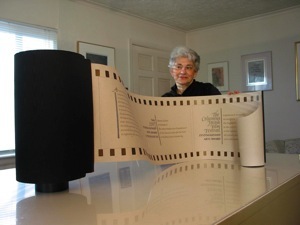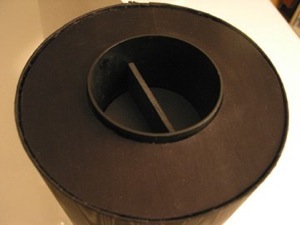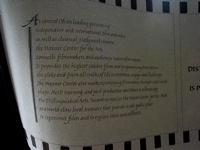wexner center for the arts film/video team
Columbus Jewish Film Festival Award 2007

wexner center for the arts film/video team
Columbus Jewish Film Festival Award 2007





Building a 9-times-life canister out of PVC pipe, board, glue and other bookbinders’ materials presented some real challenges, however:
In a standard film canister the edges of the slit from which the film strip emerges are treated with a fuzzy coating to prevent scratching of the film’s delicate emulsion. In the award, rubbing on these edges could similarly scratch the hand lettering. After trying a great many things to replicate the original material, I found a solution among the treasures I’d rescued from my mother’s sewing boxes--a roll of the softest gross-grain ribbon of just the right width and color.
In a real film canister, the internal mechanism is extruded out of plastic, but this was NOT an option for the award. 3-D printing hadn’t surfaced yet.
I realized I had to really understand the physics of the structure--to figure out how to create opposing forces that would keep the internal spindle that rides around the core from sagging to earth--and I had to do it in a hurry, too. There were just two nights before the award was due!
Just as thorny was the final hurdle of “stops”: finding a way to prevent the inevitable over-zealous person either overwinding the spool and losing the end of the strip inside the canister, or the reverse, pulling the strip so hard that the award would come off the internal spool.
This had been a tough one. When it all finally worked as I’d hoped, I breathed a deep sigh, packed it up--and slept the next 13 hours away.
Among the classic symbols of film still with us--at least while photographers continue working with them--are the simple 35mm film canister and the spoked wheel of 8mm and 16mm film.
For this award, given its grantor, the board of the Columbus Jewish Film Festival,
the film canister resonated particularly well
with its scroll structure. To enhance the double allusion, the “film” strip of the award reads in frames from right to left, as a traditional Torah.
The text is written on a single piece of Canson Mi Tientes Moonstone paper, cut from the last narrow strip of a full roll that I’d bought in 1985 for another large job. Rat-packing it all these years finally paid off: there was just enough left so I neither had to resort to piecing, nor to
laying out for another humungous roll.
The sprockets are pure optical illusion,
tiny rectangles cut from iridescent bronze paper and collaged on. They “read” like cut-outs but, unlike real ones, do not undermine
the integrity of the scrolled paper.
The canister case is of board
covered in a black silk moiré bookcloth.
Lettering was done with gouache and a variety of metal pens, including scroll (split) nibs for the display lettering and Mitchell nibs for the text,
in Italic, Bookhand, and Roman Capitals.
Details of CJFF and its annual spring celebration of film in Columbus, Ohio
are at www.cjfilmfest.org
Wexner Center for the Arts at The Ohio State University,
at www.wexarts.org.
.
©ann alaia woods 2008